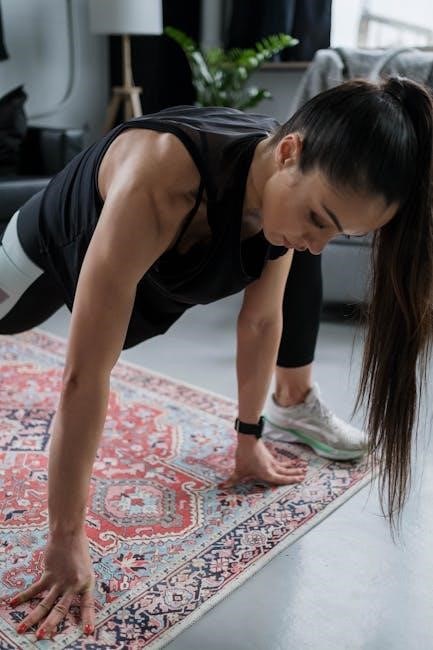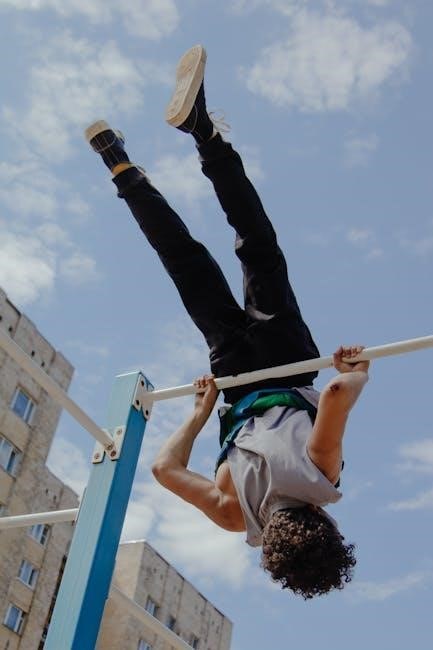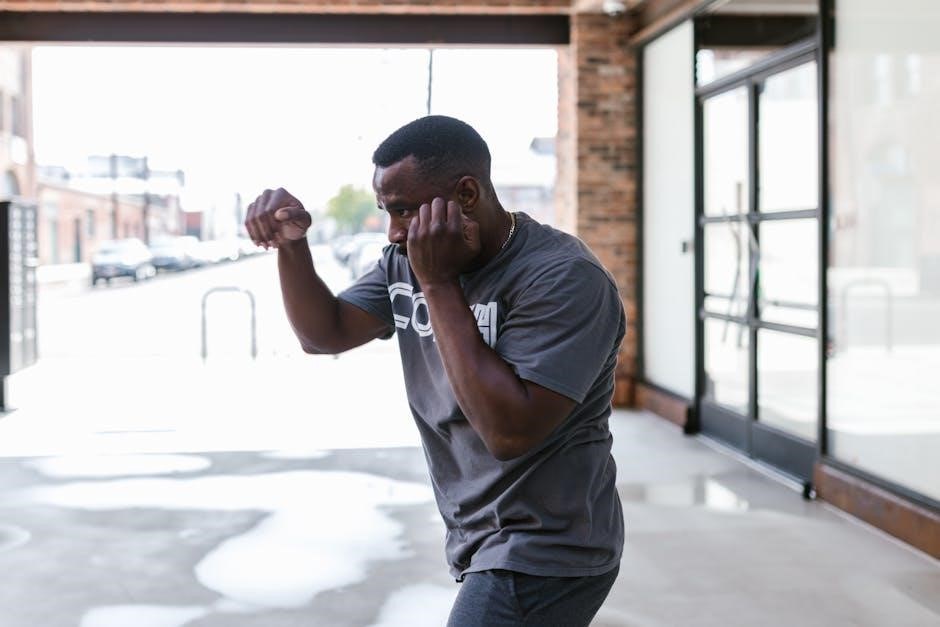Bodyweight workouts are a simple yet powerful approach to fitness, requiring no equipment and minimal space. Perfect for home or travel, they improve strength, flexibility, and cardiovascular health, suitable for all fitness levels.

Benefits
Bodyweight workouts offer numerous benefits, including improved strength, flexibility, and cardiovascular health. They are highly accessible, requiring no equipment and minimal space, making them ideal for home or travel. Bodyweight exercises enhance posture, reduce injury risk, and promote functional fitness. They are scalable to suit all fitness levels, from beginners to advanced athletes. Regular practice boosts metabolism, burns calories, and increases endurance. Plus, they improve mental focus and discipline, making them a versatile and effective way to achieve overall wellness without gym membership or special gear.

Structure
A bodyweight workout typically follows a structured approach, starting with a warm-up to prepare the body, followed by core exercises targeting strength and flexibility, and ending with a cool-down to aid recovery.
Warm-Up
A proper warm-up is essential to prepare the body for a bodyweight workout. Typically lasting 5-10 minutes, it includes dynamic stretches like leg swings, arm circles, and high knees to increase blood flow and flexibility. Gentle movements such as torso twists and hip openers help activate core muscles. Light cardio, like jumping jacks or bodyweight squats, elevates heart rate and primes the body for exercise. A well-structured warm-up reduces injury risk and enhances performance during the workout.
Core Exercises
Core exercises are fundamental in bodyweight workouts, targeting the abdominals, obliques, and lower back. Planks are a cornerstone, engaging the entire core and improving stability. Sit-ups and Russian twists target the abdominals, while leg raises challenge the lower abs. Bicycle crunches and Superman holds also effectively strengthen the core. These exercises enhance posture, balance, and overall athletic performance. Incorporating variations like hollow-body holds or side planks can add diversity to the routine, ensuring comprehensive core development without equipment.
Cool-Down
A proper cool-down after a bodyweight workout is essential for reducing muscle tension and improving flexibility. Static stretches, such as hamstring, quadriceps, and chest stretches, are highly effective. Gentle movements like leg swings and arm circles can also promote blood flow. Deep breathing exercises help lower heart rate and reduce stress. Incorporating a cool-down routine ensures a smoother recovery, prevents soreness, and enhances overall mobility. It’s a crucial step to conclude your workout safely and effectively.

Sample Routines
Bodyweight workout PDFs often include structured routines for all fitness levels, featuring exercises like push-ups, squats, and lunges. These routines are easy to follow and require no equipment.
Beginner
A beginner bodyweight workout focuses on foundational exercises like push-ups, squats, and lunges. Start with 3 sets of 10-15 reps for each exercise. Incorporate planks and tricep dips to build core and upper body strength. Aim for 3 workouts per week, allowing rest days between sessions. Warm up with light cardio and stretching to prevent injury. Cool down with static stretches to improve flexibility. Progress by increasing reps or sets as strength improves. This routine is perfect for those new to fitness, requiring no equipment and minimal space.
Intermediate
An intermediate bodyweight workout builds on foundational strength with more challenging exercises. Incorporate inverted rows, diamond push-ups, and deep squats with pauses. Aim for 3-4 sets of 10-12 reps per exercise. Introduce variations like single-leg squats and decline push-ups to increase difficulty. Perform workouts 4 times weekly, alternating between upper and lower body focus. Emphasize proper form to avoid injury and enhance results. Add dynamic stretches to your warm-up and finish with active recovery on rest days to maintain progress and prevent overtraining.
Advanced
An advanced bodyweight workout targets experienced individuals who have mastered intermediate exercises. Incorporate challenging movements like pull-ups, muscle-up progressions, single-arm push-ups, and plyometric exercises such as plyo push-ups. These exercises enhance strength, power, and endurance. Perform 4-5 sets of 8-10 reps for upper body exercises and 3-4 sets of 12-15 reps for lower body. Aim for 5 workouts per week, ensuring adequate rest days for recovery. Focus on perfect form to prevent injuries and maximize results.
Progression
Progression involves increasing difficulty, adjusting reps/sets, and mastering advanced movements. Focus on improving strength, endurance, and form to achieve long-term fitness goals effectively.
Increase Difficulty
Increasing workout difficulty enhances strength and endurance. Modify exercises by changing angles, adding pauses, or introducing single-leg variations. Incorporate plyometric movements like jump squats or explosive push-ups. Decrease rest periods between sets to boost intensity. Advanced techniques, such as deficit push-ups or single-arm pull-ups, challenge even seasoned athletes. Gradually introduce more complex movements to avoid plateaus and ensure continuous progress. Proper form must be maintained to maximize effectiveness and prevent injury, ensuring a safe and efficient path to higher fitness levels.
Adjust Reps/Sets
Adjusting reps and sets is key to progressing in bodyweight workouts. Increase reps for endurance or decrease them for strength focus. Add sets to build muscle or reduce for intensity. Every 3rd workout, decrease sets by 1 to challenge progression. For example, reduce sets from 4 to 3 or reps from 15 to 12. This approach ensures continuous improvement and prevents plateaus. Mix variations to keep workouts dynamic and effective, tailoring the routine to your fitness goals and avoiding stagnation in your training journey.
Nutrition
A balanced diet rich in protein, carbs, and fats fuels bodyweight workouts, supporting muscle growth and energy. Stay hydrated for optimal performance and recovery.
Diet
A well-structured diet is essential for maximizing bodyweight workout results. Focus on whole foods like lean proteins (chicken, fish, eggs), complex carbs (rice, oats), and healthy fats (avocados, nuts). Hydration is crucial for energy and recovery. Aim to eat 1.2–2.2 grams of protein per kilogram of body weight daily to support muscle growth. Avoid processed foods and excessive sugar to maintain optimal performance. Plan meals around workouts, ensuring a balanced intake 1–3 hours pre- and post-exercise for recovery. Adjust portions based on fitness goals, whether weight loss, muscle gain, or maintenance.
Recovery
Proper recovery is vital for muscle repair and overall progress in bodyweight training. Ensure adequate rest days between intense workouts and prioritize hydration to replenish lost fluids. Incorporate stretching or yoga to improve flexibility and reduce muscle tension. Aim for 7–9 hours of quality sleep nightly, as it plays a key role in muscle recovery and growth. Additionally, light cardio or gentle movements can enhance blood flow, aiding in the repair process. Consistent recovery practices will optimize performance and prevent injury.

Common Mistakes
Common mistakes in bodyweight workouts include poor form, overtraining, and inadequate warm-ups. Neglecting proper technique can lead to injuries, while inconsistent routines hinder progress. Always prioritize form and gradual progression.
Poor Form
Poor form is a common mistake in bodyweight workouts, often leading to injuries and reduced exercise effectiveness. For example, letting the hips sag in planks or rounding the back during push-ups can strain muscles. Similarly, neglecting to lower squats fully or rushing through lunges can limit results. To avoid this, focus on slow, controlled movements and maintain proper alignment. Using mirrors or videos to monitor technique can help identify and correct poor form. Prioritizing quality over quantity ensures safer, more effective workouts.
Overtraining
Overtraining occurs when the body is pushed beyond its recovery capacity, leading to fatigue, decreased performance, and increased injury risk. Ignoring rest days and performing excessive repetitions or sets can cause muscle strain and hinder progress. Signs include persistent soreness, lack of energy, and poor sleep. To avoid overtraining, balance workout intensity with adequate rest, ensuring 48-72 hours of recovery between sessions for the same muscle groups. Listening to your body and adjusting routines is crucial for sustainable fitness gains and long-term health.
Inadequate Warm-Up
An inadequate warm-up is a common mistake that can lead to injuries and subpar performance. Warming up prepares muscles for exercise, increasing blood flow and flexibility. Skipping this step can result in poor form, strained muscles, and reduced workout efficiency. A proper warm-up should include light cardio, such as jumping jacks or jogging in place, followed by dynamic stretches like arm circles and leg swings. Neglecting this routine can hinder progress and increase the risk of preventable injuries, making it essential to prioritize a thorough warm-up before every session.

